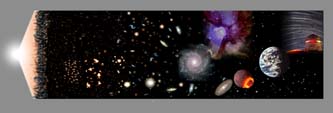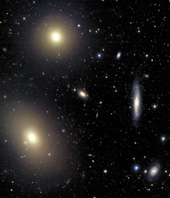(Originally published on: http://www.pparc.ac.uk/Nw/young_galaxies.asp )
Until now, astronomers have been nearly blind when looking back in time to survey an era when most stars in the Universe were expected to have formed. This critical cosmological blind-spot has been removed by a team, including a UK scientist, using the Frederick C. Gillett Gemini North Telescope, showing that many galaxies in the young Universe are not behaving as expected some 8-11 billion years ago.
The surprise: these galaxies appear to be more fully formed and mature than expected at this early stage in the evolution of the Universe. This finding is similar to a teacher walking into a classroom expecting to greet a room full of unruly teenagers and finding well-groomed young adults.

The results were announced today at the 203rd meeting of the American Astronomical Society in Atlanta, Georgia. The data will soon be released to the entire astronomical community for further analysis, and four papers are nearing completion for publication in The Astrophysical Journal and The Astronomical Journal.
Dr. Isobel Hook, leader of the UK Gemini Support Group, based at Oxford University, is a member of the multinational Gemini Deep Deep Survey (GDDS) team who undertook the investigation. She explains how the technique works. The team used a special technique to capture the faintest galactic light ever dissected into the rainbow of colours called a spectrum. In all, spectra from over 300 galaxies were collected, most of which are within what is called the "Redshift Desert," a relatively unexplored period of the Universe seen by telescopes looking back to an era when the universe was only 3-6 billion years old.
"The Gemini data is the most comprehensive survey ever done covering the bulk of the galaxies that represent conditions in the early Universe. These are the massive galaxies that are actually more difficult to study because of their lack of energetic light from star formation. These highly developed galaxies, whose star-forming youth is in fact long gone, just shouldn't be there, but are," said Co-Principal Investigator Dr. Karl Glazebrook (Johns Hopkins University).
Astronomers trying to understand this issue might have to put everything on the table. "It is unclear if we need to tweak the existing models or develop a new one in order to understand this finding," said the survey's third co-principal investigator, Dr. Patrick McCarthy (Observatories of the Carnegie Institution). "It is quite obvious from the Gemini spectra that these are indeed very mature galaxies, and we are not seeing the effects of obscuring dust. Obviously there are some major aspects about the early lives of galaxies that we just don't understand. It is even possible that black holes might have been much more ubiquitous than we thought in the early Universe and played a larger role in seeding early galaxy formation."
What is arguably the dominant galactic evolution theory postulates that the population of galaxies at this early stage should have been dominated by evolutionary building blocks. Aptly called the Hierarchical Model, it predicts that normal to large galaxies, like those studied in this work, would not yet exists and would instead be forming from local beehives of activity where big galaxies grew. The GDDS reveals that this might not be the case.
The spectra from this survey were also used to determine the pollution of the interstellar gas by heavy elements (called "metals") produced by stars. This is a key indicator of the history of stellar evolution in galaxies. Sandra Savaglio (Johns Hopkins University), who studied this aspect of the research said, "Our interpretation of the Universe is strongly affected by the way we observe it. Because the GDDS observed very weak galaxies, we could detect the interstellar gas even if partly obscured by the presence of dust. Studying the chemical composition of the interstellar gas, we discovered that the galaxies in our survey are more metal-rich than expected."
Previous studies in the Redshift Desert have concentrated on galaxies that were not necessarily representative of mainstream systems. For this study, galaxies were carefully selected based upon data from the Las Campanas Infrared Survey in order to assure that strong ultraviolet emitting starburst galaxies were not oversampled. "This study is unique in that we were able to study the red end of the spectrum, and this tells us about the ages of old stars," says Dr. Abraham. "We undertook incredibly long exposures with Geminiabout ten times as long as typical exposures. This let us look at much fainter galaxies than is usually the case, and let us focus on the bulk of the stars, instead of just the flashy young ones. This makes it a lot easier for us to work out how the galaxies are evolving. We are no longer guessing at it by studying young objects and assuming the old objects were not contributing much to the story of galaxy evolution. It turns out that there are lots of old galaxies out there, but they're really hard to find."

This Canada-France-Hawaii Telescope image shows a small section of the nearby Virgo cluster of galaxies dominated by two giant elliptical galaxies on the left side of the image. The Gemini Deep Deep Survey (GDDS) studied much more distant galaxies than those shown in this image. However, the nearby elliptical galaxies in this image are thought to be older and even more massive, yet similar to some of the larger distant galaxies studied in the GDDS.
Note the bright, smaller and bluer spiral galaxies on the right (center and bottom). These nearby spiral galaxies have active star formation occurring that makes them appear brighter and bluer. The limited number of galaxies observed spectroscopically in the redshift desert prior to the GDDS were mostly of this type. The GDDS allowed astronomers to thoroughly survey the more massive, redder yet dimmer galaxies as well.
Light from galaxies in the nearby Virgo cluster has traveled for approximately 45 million years, whereas light from the galaxies studied in the GDDS has been traveling between 8-11 billion years to reach us.
Origin: http://www.pparc.ac.uk/Nw/young_galaxies.asp
Category: Perspective








